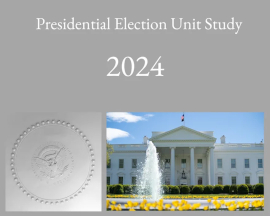Presidential Election Unit Study 2024 from Silverdale Press was written for students in grades six through twelve. It differs from other election unit studies I have reviewed as it includes sections that pertain particularly to the 2024 election and how events from the 2020 election are shaping it. While it would be ideal to complete this study in the weeks leading up to the November 2024 election, the study will still be pertinent for at least a year or two after that.
There are eight lessons in the study. Ideally, you should use the study for four months prior to the election, even if you take a summer break in the middle of it. You should plan to spend two weeks per lesson. If you save it till the fall semester, you'll have to condense your lessons. However you schedule it, finishing right before the election is highly motivating for students and helps them get excited about both the election and the study.
Presidential Election Unit Study 2024 is available only in PDF format. While you might want to print it out, you will also want to use the weblinks in the activity sections of the PDF that make it simple to jump to websites for information and activities.
This unit study is written for families, however, it might work as well or better in a co-op setting where you can have discussions and debates. You have permission to purchase one book and use it with your entire family, but co-op groups need to have each student purchase a book.
Each of the study's eight lessons deals with one aspect of the election process, and they are titled Primaries; Parties and Conventions; Issues and Platforms; The Electoral College; Campaign Strategy; Advertising and Media; Debates; and Voting, Election Day, and the Inauguration. You can see from the lesson titles that this study goes beyond the legal and historical aspects of elections to explore how candidates position themselves to appeal to voters, how they make use of various forms of media, and the critical role that debates usually play in elections.
Lessons draw heavily upon recent elections—late twentieth century to the present—for examples. Each lesson follows a similar pattern. First students read the lesson material from Presidential Election Unit Study 2024. Lessons are illustrated and include factual information, stories, and examples from actual elections. For example, the second lesson on Parties and Conventions has a section on “From 2020 to 2024" that reviews the nominating conventions held in 2020 in the midst of COVID-19 lockdowns.
Students are given a list of key terms for which you can have them write definitions if you think it helps. This is one of many ways in which you might adapt the course to suit different students.
Next, students write out answers to “Questions for Review,” which are primarily comprehension questions. The course includes a 10-page answer key with suggested answers.
“Questions for Debate,” the next section, might be used in several ways: for discussion, as the subject of a short position paper, or as the topic for an actual debate between two students.
“2024 Exercises” are specific to the 2024 election and require research and analysis. For example, one assignment directs students to “Research your state’s role in the primary season. When does your state vote? Does it hold a caucus or primary? Based on its place on the calendar, how much influence did it have? How many delegates did each candidate win from your state?” (p. 19). There might be three or four such assignments, and students will complete one of them. Most of the “2024 Exercise” questions will still be useful even a few years down the line.
“Historical Exercises” offer students a few additional questions for research, but these questions are based on past elections. For example, “Watch Hillary Clinton and Bernie Sanders announce that they will run for president in 2016. What were the differences between the announcements? Whose did you like better? How were their messages different?” (p. 20).
Both exercise sections often direct students to websites where they can find the information or videos they need.
A section toward the end of each lesson, “Get Involved,” offers suggestions such as volunteering for a political party, writing a letter to the student's congressional representative, and conducting a survey of people's understanding of how the Electoral College works. You can choose whatever activities you wish.
The final section for each lesson has links to videos along with questions or research assignments related to each video.
The Presidential Election Unit Study 2024 was clearly written by someone who knows the election process. Students will probably find some of the inner workings of elections fascinating as they learn about brokered conventions, why candidates run both positive ads about themselves and negative ads about their competitors, and the importance of social media posts in elections. Most parents are likely to learn something new as well.
Since the study is intended for students in grades six through twelve, you will need to make choices to suit each student. It should be relatively easy to adapt the level of difficulty by requiring more research and writing from older students than from younger students. You can download a sample chapter from the publisher’s website for free to check it out.
The Presidential Election Unit Study 2024 can be used on its own or it might serve as a supplement to a more comprehensive course on the U.S. government. Depending upon the amount of research and writing required, it might also provide some language arts credit. Even if it serves only as an elective course, it offers a rare opportunity to capitalize on current events to make learning come alive.









